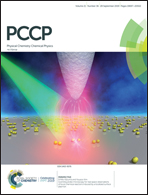Molecular dynamics simulation studies of the structure and antifouling performance of a gradient polyamide membrane†
Abstract
The polyamide (PA) layer on the surface of thin-film-composite reverse osmosis membranes is the core aspect of membrane-based desalination technology. In recent years, molecular dynamics simulations have been increasingly used to disclose the physicochemical properties of the PA layer. However, the currently reported all-atom PA layer models do not exhibit gradient variation of the structural properties of the layer, and they can only represent the innermost region of the PA layer. With the help of our recently developed universal toolkit “MembrFactory”, this paper reports a modeling method that can be used to construct a gradient crosslinking model and surface grafting model for the PA layer. A fully atomistic model of the PA layer was constructed, in which the degree of crosslinking (DC) was changed gradiently along the thickness direction. The structure of the PA layer model and the transport dynamics of the water molecules within it were systematically investigated using equilibrium molecular dynamics simulations. We found that the DC is the lowest and the water molecules have the strongest self-diffusion ability in the interfacial region of the PA layer model. Meanwhile, the pore size is distributed widely in the region. Subsequently, we modified the surface of the PA layer model with PEG coatings, and their coverage ratio was around 75%. The radial distribution function analysis showed that water molecules prefer to coordinate with the oxygen atoms in PEG. Furthermore, two contaminant molecules, 1-ethyl-2-methyl benzene and n-decane, were selected to investigate the antifouling properties of the PEG-modified PA layer. By analysing the trajectories of the pollutants and calculating the potential of the mean force, we found that the antifouling performance of a PEG-modified PA layer is not only related to the hydrophobicity and the size of the pollutant, but is also related to the coverage ratio of the PEG layer.



 Please wait while we load your content...
Please wait while we load your content...